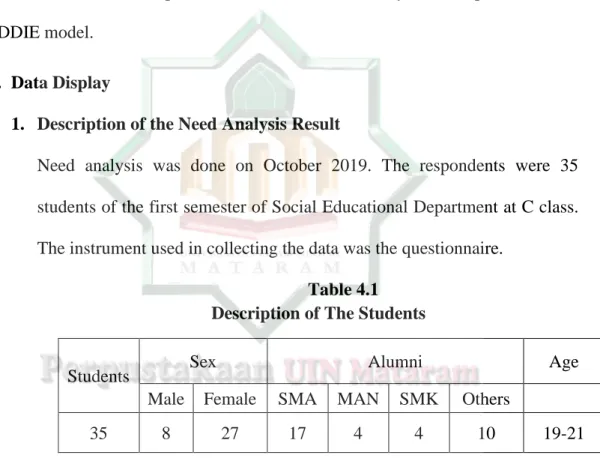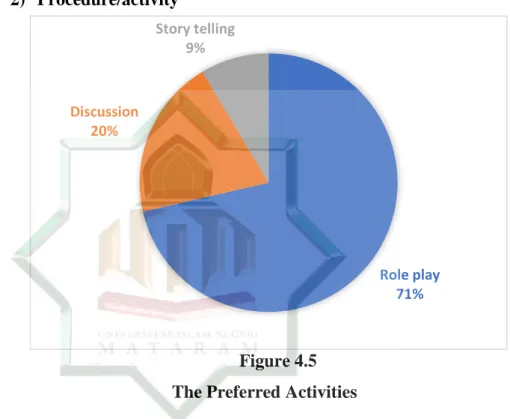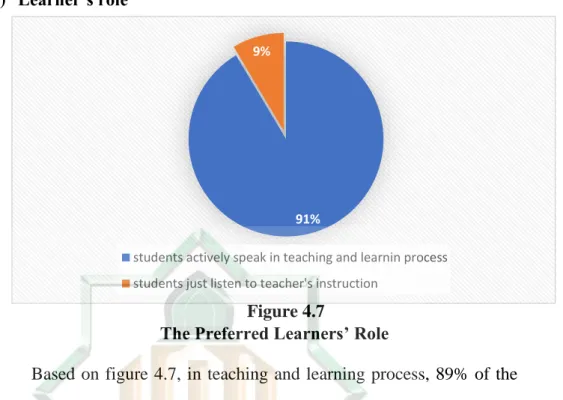The writer realized that this paper could not be achieved without help from various quarters. All lecturers at the English Study Program, Faculty of Education UIN Mataram. Ibnu Hizam, M.Sc. Pd as Head of Department of Social Education who allowed the writer to do the research.
The entire R&D team, Jaya Kusuma Wardana, Husnul Khotimah, Ermayanti and Yudia Arditha Muslimah, who helped the writer during the research. The writer's beloved parents, Saiman and Baiq Karti, the writer cannot thank them enough for their prayers, sacrifice, never ending love and support. The author's beloved brothers, Chandra, Gunawan, Jodi and sister Dewy, who provide constant support and encouragement.
The author's special friends "Salak Kenjarian Club", Jian, Jaya, Fitri, Nung, Umam, Ancung and Kika. 11.All the author's friends from Bebie, MA Nida'urrahman, and TBI A Limited Edition, especially Surur, Asren and Julian whom the author cannot name one by one.
INTRODUCTION
- Background of Research
- The Statement of Problem
- Objective of the Development
- Specification of Product
- Urgency of the development
- Assumption and Limitation of Product
- Definition of Key Terms
- Systematical Discussion
Based on the result of the interview with several students from the Department of Social Education at UIN Mataram, it shows that the problem faced by the students is that the English materials that were taught did not support them. From the issues elaborated above, the question emerges that which EAP textbook is suitable to be developed to help the students learn English in the Department of Social Education in UIN Mataram. This research aims to develop suitable EAP textbook to help students learn English at the Social Educational Department of UIN Mataram.
The outcome of this research and development will be an EHP textbook for the students of the Social Education Department of UIN Mataram. It will be useful for the students of the Social Education Department to learn much easier to support their academic English competence. The development of EHP textbook for the students of the Social Education Department is according to some assumptions below.
Students of the Department of Social Education should learn English for academic purposes which is based on their needs in order to help them acquire English academic competence which is able to help them communicate in the social environment and academic. In addition, teaching English for academic purposes begins with the analysis of students' language background, what they already know and what they need to know.
REVIEW OF RELATED LITERATURE
- Review of Previous Research
- Theoretical Bases
- Materials Selection
- Adapting Materials
The Department of Social Education is one of the departments in UIN Mataram that studies social and economic. This chapter contains the development model, development procedure, and product testing. The difference is that the previous study includes students, lecturers and casual managers of the University of Yogyakarta, which focused on analyzing and developing web-based EAP materials.
Learning English for Academic Purposes in Higher Education in Rwanda: A Case Study of the College of Business and Economics at the University of the Western Cape (2016)'16. This was a case study design conducted at the University of the Western Cape (French) involving students and teachers as data sources. 16 Ngirabakunzi Ndimurugero “Learning English for Academic Purposes in Higher Education in Rwanda: A Case Study of the College of Business and Economics at the University of the Western Cape, Thesis, University of the Western Cape, 2016.
The first occurs at the beginning of the course, when teachers propose their textbooks and materials. The first stage is evaluating the content of the book against its stated goals.
METHOD OF THE DEVELOPMENT
Model of the Development
The researcher encouraged the material in the classroom to teach the students of the Department of Social Education as the subject of the research. The purpose of the interview was to get the students' suggestions about which materials are suitable for them. For this purpose, the researcher used the percentage of responses of students and professionals in the questionnaires.
Data on students' knowledge levels showed that 83% of students were at the basic level. Based on the needs analysis data, 100% of students think that mastering English is very important. The title of the textbook is EAP Textbook for The Students of Social Educational Department.
One of the students said that there were several dialogues that I thought were quite difficult. The data presentation of the respondents and the result of the questionnaire are presented in the following tables.

Procedure of Development
Try Out of Product
- Design of the Try Out
- Subject of the Try Out
- Techniques and Instruments of Data Collection
- Technique of Data Analysis
- Validity and Reliability
Descriptive statistics were used as a way to present and describe some of the data in the questionnaire. After getting the feedback from that class, the researcher made some revisions. a) Description of the first test. However, they found some difficult words on some dialogues, so some of the students suggested adding more vocabulary items.
After getting the feedback from the class, the researcher made some revisions. a) Description of the second test.
Conclusion
Suggestions
Dissemination and Further Product Development
Standard Competences: Students are able to communicate using English in everyday life in a specific context. Objectives of the course: Students can use English in the form of a role-play, a mini-drama, a presentation. Self-presentation in a general situation: Students are able to recognize expressions when they present themselves and others in a general situation; students can compose dialogues containing these expressions and can practice them orally.
Self-presentation in a formal situation: Students are able to recognize expressions when they present themselves in a formal situation; students are able to make a speech containing this expression and able to practice them orally. Showing concern and giving compliments: Students can recognize expressions when showing concern; students can compose dialogues containing these expressions and can practice them orally. In the shop: pupils can recognize expressions when giving instructions in a shop; students can compose dialogues containing these expressions and can practice them orally.
Students are able to identify expressions when giving opinions; students are able to make dialogues containing these expressions and are able to practice them orally. Interrupting: Students are able to identify expressions when interrupting a discussion; students are able to make dialogues containing these expressions and are able to practice them orally. Give a presentation: Students are able to identify expressions when giving a presentation; students are able to make a presentation, are able to present it orally.

